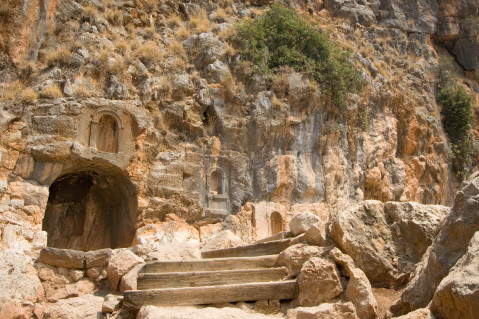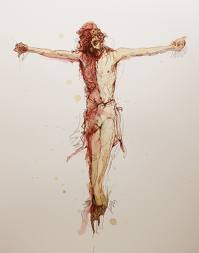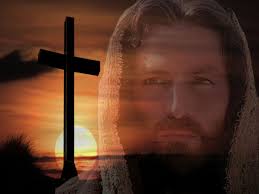
– 15-09-2024 –
Twenty-Fourth Sunday in Ordinary time
Gospel Reading: Mark 8:27-35
vs.27 Jesus and his disciples left for the villages round Caesarea Philippi. On the way he put this question to his disciples,
“Who do people say I am?”
vs.28 And they told him. “John the Baptist,” they said “others Elijah; others again, one of the prophets.”
 vs.29 “But you,” he asked “who do you say I am?”
vs.29 “But you,” he asked “who do you say I am?”
Peter spoke up and said to him, “You are the Christ.”
vs.30 And he gave them strict orders not to tell anyone about him.
vs.31 And he began to teach them that the Son of Man was destined to suffer grievously, to be rejected by the elders and the chief priests and the scribes, and to be put to death, and after three days to rise again;
vs.32 and he said all this quite openly. Then, taking him aside,
Peter started to remonstrate with him.
vs.33 But, turning and seeing his disciples, he rebuked Peter and said to him,
“Get behind me, Satan! Because the way you think is not God’s way but man’s.”
vs.34 He called the people and his disciples to him and said,
“If anyone wants to be a follower of mine,
let him renounce himself and take up his cross and follow me.
vs.35 For anyone who wants to save his life will lose it;
but anyone who loses his life for my sake, and for the sake of the gospel, will save it.”
*******************************************
We have four commentators available from whom you may wish to choose .
Michel DeVerteuil :Holy Ghost Priest, director of the Centre of Biblical renewal .
Thomas O’Loughlin: Profof Hist Theology Uni of Nottingham NG7 2RD
Sean Goan:Studied scripture in Rome, Jerusalem and Chicago
Donal Neary SJ: Editor of The Sacred Heart Messenger and National Director of The Apostlship of Prayer.
****************************************
Michel DeVerteuil
Lectio Divina with the Sunday Gospels Year B
www.columba.ie
Textual Comments
This passage is in three sections, each of which has deep implications for our life of faith. The passage as a whole helps us understand and celebrate our own journey to commitment, or that of someone who has touched our lives. We start, as always, from experience, remembering a time when we got a better insight into the truth of Jesus, we realized for the first time that God truly became a human being among us.
Verse 27a : In this verse Jesus takes the decision to “leave for the villages round Caesarea Philippi.” It was on that journey that he put his question to the disciples. He made a conscious decision, and brought out a new profession of faith from them.
Verses 27b-29 : “Who do people say I am?” We can identify with Jesus. There have been times when we have been in leadership positions in a community and have stopped to look at our work, to evaluate our impact on those around us.
“Who do people say I am? Do people understand what I am doing, what I am trying to communicate?” Nowadays we do this systematically with surveys and evaluations on social media.
 As Christians entrusted with the mission to proclaim the Good News we often ask the questions: when people look at us, who do they say we are?
As Christians entrusted with the mission to proclaim the Good News we often ask the questions: when people look at us, who do they say we are?
We can also identify with the disciples. Every so often we look at the image of Jesus we carry within us – who is he for us? We may find that our image of him has changed over time, become more concrete, more real, and more coherent with our experiences. We celebrate the moments when we have become conscious of our journey to him.
Verse 30 : Jesus often instructs his disciples not to tell others what they have “seen”. We celebrate wise teachers who warned us not to share our deepest insights with those who have not yet made the journey. We would be robbing them of the joy of making their own discovery with its own particular twists and turns. We thank God for the times when we have waited respectfully for others to know Jesus – and learnt something new about him from them.
Verses 31-33 : We remember a time when someone we loved dearly – a friend, a child, a spouse – made a decision which they dreaded and yet accepted as necessary. We knew it would cause them pain, and we wanted so much to spare them! We tried to dissuade them, urging them to compromise and chose an easier path. They refused, and today we are grateful for their integrity.
Or it may be that we ourselves have made that journey, and today we thank God that we were able to.
Verses 34 and 35 are a meditation on the preceding incidents. We must make sure that we do not read them in a vague or abstract way, or as moralizing. We recognize each statement as true, corresponding to experience.
Verse 34 must remind is of concrete ways in which we (or others) “renounced ourselves” and as a result became better “followers of Jesus” – forgiving a person (or group) for whom we felt resentment, not accepting a high position, or giving up an addiction, etc.
Verse 35 evokes things that we have risked “losing” and then “found” again in a deeper way – a friendship, prestige, inner peace, a harmonious community or workplace.
Prayer Reflection
 Lord, we thank you for the quiet times we have taken, away from the busyness of our daily life, to be with you and take stock of our lives: long walks on the beach, a sit down in a park, retreats, quiet holidays.
Lord, we thank you for the quiet times we have taken, away from the busyness of our daily life, to be with you and take stock of our lives: long walks on the beach, a sit down in a park, retreats, quiet holidays.
Away from the pressures of family, co-workers and friends, those who wish us to conform to whatever image they have of us, we asked you, Lord, “Who do you say I am?” and slowly we began to understand our own special vocation, the life of Jesus within us.
“True love is self-sacrificing because it is about making choices, and some of these will always be made at personal cost to ourselves. In the name of the God of costly love we take up the daily burden of being open to costly choices. In this way we too will be broken, but broken as bread is broken, in order to be shared.” .…Lavinia Byrne
Lord, we thank you for friends who, at major turning points in their lives, spoke openly to us as Jesus spoke to his disciples.
They asked us whether we understood what their destiny called them to.
They shared with us quite openly that what they had to do would entail being rejected by elders, chief priests and scribes, and even being put to death.
 They asked us to have faith that ultimately their suffering would result in resurrection and new life.
They asked us to have faith that ultimately their suffering would result in resurrection and new life.
They were laying down their lives for the sake of something higher,
knowing that only by being true to what they believed could they save their lives.
Forgive us that when we did not understand we took them aside and started to remonstrate with them.
We thank you that when they heard us they rebuked us and told us, “Get behind me, because the way you think is human, not divine.”
“Death as an image for the path of transformation points to a dying to the world of conventional wisdom as the center of one’s security and identity and a dying to the self as the center of one’s concern. The path of death is also, for Jesus, the path to new life. It results in rebirth, a resurrection to a life centered in God.” …M.J. Borg
Lord, we know you are asking us once again, as you did when we first became your disciples, “Who do you say I am?”
 Our childhood images no longer make sense to us, they seem to have disintegrated,
Our childhood images no longer make sense to us, they seem to have disintegrated,
and we are frightened of being rejected by the elders, chief priests and scribes within us.
Remind us that we need not be afraid of being put to death because after three days we will rise again.
How true it is that if we are too anxious to save things that are precious to us we lose them,
whereas if we are prepared to lose them for the sake of the higher values of honesty we will save them.
“It is evident that women are meant to form part of the living and working structure of Christianity in so prominent a manner that perhaps not all their potentialities have yet been made clear.” …Pope Paul VI, On the dignity and vocation of women
Lord, there are women all over the world today Who feel called to the priestly ministry,
But they are destined to suffer grievously, to be rejected by elders, chief priests and scribes in our communities.
Encourage them to never loose heart, but to trust that your will will come to pass.
Help them to take up their destiny as Jesus took up his cross,
Understanding the concerns of those who oppose them,
While remaining true to his Spirit within them.
Whatever they lose for his sake and the sake of the gospel they will save it.
*************************************
Thomas O’Loughlin
Liturgical Resources for the Year of Matthew
www.columba.ie
Introduction to the Celebration
This year we have been reading the gospel of Mark each Sunday. Today we come to its centre: Mark built his whole story around the moment of declaration by the disciples about who they believed Jesus really is: ‘You are the Christ!’ Once, the disciples had recognised his full identity, they were ready to be presented with the demands of being disciples, people who had chosen to follow his way.
Today, this gospel presents us with the same challenge. By assembling here we are declaring our belief in the identity of Jesus as the Christ, the Son of the Father. But having declared that faith, we now have to face the challenge of following his way. This way is the way of renouncing self, of taking up our crosses, and of being prepared to see in his way a radically different way of living.
Gospel: Mk 8:27-35

The ruins of Banias, known biblically as Caesarea Philippi
Today’s gospel is presented by Mark as a single scene taking place at Caesarea Philippi (the scene extends from 8:27 to 9:1); but it is made up of three parts:
first, the confession of faith that Jesus is the Anointed One (vv 27-30);
second, the prediction of the passion, death, and resurrection (vv 31-33); and, third, that the disciple can expect his / her life to follow the same pattern as that of the Christ (vv 34-35).
All these elements of the scene are present also in Matthew and Luke, but the way they follow on from one another in Mark — almost like logical consequences — is found most clearly in Mark and gives this gospel an unique tone.
We tend to break them apart: one bit is ‘christology’, another is about ‘encouraging the twelve‘, and the other is about discipleship — but for Mark this passage is a unity and it is at the very centre of his preaching. Here it all becomes plain: who Jesus is and his task and his people. Following is about who one follows, who that leader is and what he does, and about what is expected for those who come in the wake of the leader. For Mark, here we have his message in a nutshell. Yes, the Christ will rise, but before that there is the experience of being with him and the cross: his cross and one’s own. Once we see this as Mark’s core message, it is easier to see why his preaching, in its original form, ended with the death and burial of Jesus.
Resurrection is but a promise for the future for those who are, as disciples, carrying their crosses.
Homily Notes
 1. The gospel presents us with a single message in two stages: if you acknowledge that Jesus is the Christ, then you embark on a life of discipleship. However, that is too complex a notion to try to communicate to an average congregation of people in various stages of life, with differing levels of religious commitment, a variety of listening abilities, educational backgrounds, and Christian spiritual ‘awareness‘ — all in less than 10 minutes! So it is perhaps better to focus on a single aspect of the gospel and try to explicate that and help people come to a deeper understanding of that one aspect of today’s gospel.
1. The gospel presents us with a single message in two stages: if you acknowledge that Jesus is the Christ, then you embark on a life of discipleship. However, that is too complex a notion to try to communicate to an average congregation of people in various stages of life, with differing levels of religious commitment, a variety of listening abilities, educational backgrounds, and Christian spiritual ‘awareness‘ — all in less than 10 minutes! So it is perhaps better to focus on a single aspect of the gospel and try to explicate that and help people come to a deeper understanding of that one aspect of today’s gospel.
2. Two themes come easily to mind.
The first is a homily built around ‘the challenge‘ of discipleship. In its crudest form it sounds like: if you believe, then you must be ready to die for your beliefs. The problem is that unless one is in an extreme situation, this is just ‘hot‘ rhetoric that excites a few hotheads in the congregation, but switches off most as a harangue. We can all offer challenges — and they are offered de facto in the liturgy today, but preaching needs to tap into something more reflective. Moreover, if preachers throw out challenges, then it has to be transparent that they are ready to be as daring themselves. Most clerics are seen by the congregations as anything but that: they are company men who keep the show running but are not prepared to offer challenges to their own leaders about discipleship, so why are they willing to throw out challenges to their flocks. So, unless there is a pressing need to adopt the challenge model, leave it alone.
The second is based on the theme of ‘faith without words is dead‘; and takes the form that belief must involve making a practical difference in the world around you, faith is not ‘pie in the sky when you die’ but social engagement. However, that can become a simple exhortation to moral or social work rather than a homily which helps people hear what the Spirit is saying (which includes the notion that an incarnational faith must engage with the world around us). To preach that discipleship involves works is either to state the obvious, or else requires that there is some very specific task that a community needs to undertake as part of its particular discipleship — but even then care must be taken that a homily does not become simply an advertising slot for some specific task.
3. An altogether different approach is to focus on the notion of the cross which lies at the heart of Mark’s preaching today.  Most preachers are so familiar with the cross as a concept, a liturgical object, or even an item of decoration, that we fail to appreciate just how off-putting many people — many Christians included — find it as an object, icon, image, and symbol. The notion of glorifying the image of a tortured, contorted body on an instrument of execution seems to smack of the grotesque. It can appear to glorify all that is vile in human nature, to rejoice in suffering for its own sake, and to be life-rejecting, joy-rejecting, and convey a message that religion is a dismal, dour business.
Most preachers are so familiar with the cross as a concept, a liturgical object, or even an item of decoration, that we fail to appreciate just how off-putting many people — many Christians included — find it as an object, icon, image, and symbol. The notion of glorifying the image of a tortured, contorted body on an instrument of execution seems to smack of the grotesque. It can appear to glorify all that is vile in human nature, to rejoice in suffering for its own sake, and to be life-rejecting, joy-rejecting, and convey a message that religion is a dismal, dour business.
4. Many apologists then jump up and shout that that is not what it means, that is not how Christians see the world, that is not the message of the cross! Yes, this is all true; but the problem with symbols is that they communicate with us before we hear what they mean. And, in a culture where faith-meanings are not absorbed simultaneously with the faith-symbols, we have a problem.
5. Tackling that problem in the homily situation is a two-step process. Firstly, acknowledge the problem. This will come as surprise to many in the congregation, but it will be useful for that group to realise that many fundamental Christian symbols are no longer ‘obvious to all‘. However, there will be some people in every gathering who will share this cultural unease with the cross and having that unease openly spoken about is often a great help: the individual is not alone in finding this aspect of faith/liturgy difficult.
 6. The second stage is to ask why the earliest Christians focused on the cross as one of their basic symbols — along with baptism and the Eucharist? Why, when they preached that Jesus is risen as their basic message, did they bother with the cross? Christians focus on the cross because of a realistic assessment of what living a life of discipleship will cost.
6. The second stage is to ask why the earliest Christians focused on the cross as one of their basic symbols — along with baptism and the Eucharist? Why, when they preached that Jesus is risen as their basic message, did they bother with the cross? Christians focus on the cross because of a realistic assessment of what living a life of discipleship will cost.
Working honestly and justly, working for reconciliation is not only difficult, it generates opposition, and often provokes ridicule from others. In every generation Christians have realised that if they seek to follow the way of the Son of Man, then they will encounter the cross.
7. Using it as a symbol is a declaration of what living as a disciple of Jesus will involve. Using it, we can never be accused of making false promises under a ‘trade descriptions’ act‘!
8. This sort of homily is not a theology of the Holy Cross, rather it is following up the notion of the cross as used in today’s gospel, and as part of a low level programme of apologetics: giving sisters and brothers answers to the questions round about us.
**********************************
Sean Goan
Let the reader understand
www.columba.ie
Gospel
We come now to a crucial moment in Mark’s narrative as we hear the first of three predictions of Jesus’ passion and death. From the beginning of the gospel there have been many expressions of wonder and amazement at what Jesus has done and these have often been accompanied by the question: ‘Who can this be?’ Jesus, however, has attempted to keep a lid on the question of his identity, as though he wanted it kept a secret. Now in these important verses we learn why.
Jesus is interested above all in the response of faith and that is why he asks the disciples: ‘Who do you say that I am?’ Peter answers, acknowledging that Jesus is the ‘Messiah‘. This is a Hebrew word and simply means the anointed one, but in the minds of the Jews of first-century Palestine it means much more. Peter is saying that Jesus is the long awaited fulfilment of the scriptures, the one to set his people free from foreign domination and who would usher in a great period of restoration and renewal. Jesus accepts the title but immediately begins the task of trying to bring his disciples to understand that he is not the type of Messiah they expect. Quite the opposite in fact, for the kingdom he proclaims will meet with fierce opposition and he will suffer the ultimate penalty for his faithfulness to it. What’s more is that he expects his disciples to walk the same path.
Reflection
As Christians we pray daily using the words Jesus taught us: ‘Thy Kingdom come.’ When we do this we are saying that we want the world to be the way God wants it. In other words ‘a  place of peace and justice where no-one suffers through poverty, war or oppression. If this is what we want then we must live in a way which helps to bring this about, we must be committed to change. Such a choice might leave us like the Servant in the first reading facing abuse and insults from those who would prefer to leave things as they are. This is what Jesus is talking about in today’s gospel: taking up our cross to follow him does not mean we are to go looking for suffering; rather it means accepting that choosing the way of God’s kingdom will cost us.
place of peace and justice where no-one suffers through poverty, war or oppression. If this is what we want then we must live in a way which helps to bring this about, we must be committed to change. Such a choice might leave us like the Servant in the first reading facing abuse and insults from those who would prefer to leave things as they are. This is what Jesus is talking about in today’s gospel: taking up our cross to follow him does not mean we are to go looking for suffering; rather it means accepting that choosing the way of God’s kingdom will cost us.
In short, faith without works is dead!
***************************************
Donal Neary SJ
Gospel Reflections for Sundays of Year B
www.columba.ie
Losing and Finding
Giving up is part of life – you give up your time and money for your children and grandchildren. Parents say it was worth it for the joy in their faces. A person goes to work for the poor and gives up a better job. You want to do more study and know you have to leave some leisure aside that you like. In sport we sacrifice a lot to train and to do well. But something else comes through for us when we give up. If it’s real and true we get back a lot. It seems strange for Jesus to say – lose your life to save it. He’s talking about losing good things, to get better.
 This can be a big challenge in a culture today that is very ‘me‘ conscious. We can find that personal concerns take total precedence, without enough care for others. But as long as one person on this globe is hungry or homeless or seeking refuge, the work of Jesus is never done.
This can be a big challenge in a culture today that is very ‘me‘ conscious. We can find that personal concerns take total precedence, without enough care for others. But as long as one person on this globe is hungry or homeless or seeking refuge, the work of Jesus is never done.
Losing life and saving life with Jesus is a call to community, to neighbourhood and the world, to make our part of the world a better place.
My own life may be my main concern, my circle of care may extend just as far as myself, ignoring care in a sustained way for the stranger or the outcast, then I am called to the challenge of the gospel to lose selfishness, and find the generosity given in my heart by God.
Think ahead to today or this week.
Offer love and service to God.
Lord, teach me to be generous in your service